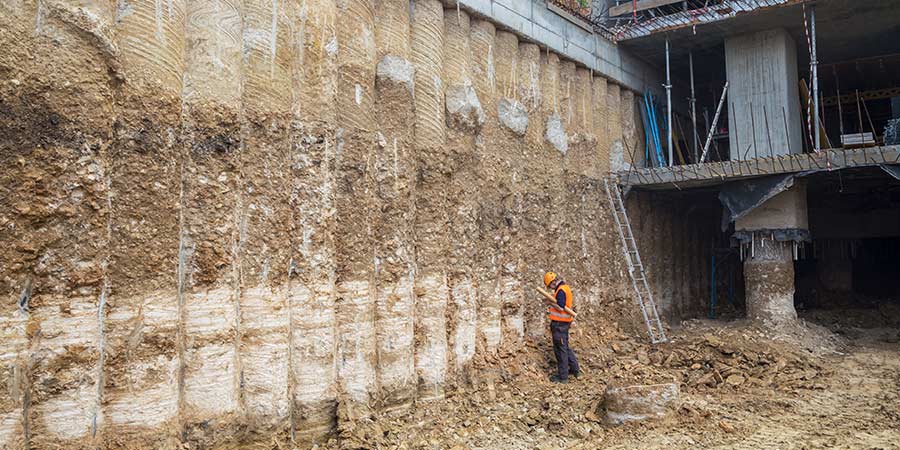Understanding your geotechnical report

A geotechnical report is an invaluable tool for any commercial building and infrastructure project. This detailed site condition report is essential not only for understanding the mechanical properties of the site but for assessing the risk factors for water infiltration and understanding the soil composition, including whether the soil contains any harmful chemicals or gases. Reviewing the following report elements will help determine waterproofing needs.
Groundwater table.
Understanding the elevation of the groundwater table is critical both from a structural standpoint and for determining what waterproofing is needed. This information should be reviewed in conjunction with the projected rainfall for the region. If the water table will come close to the slab elevation, evaluate how quickly rainwater is expected to dissipate through the type of soil at the site.
Your geotechnical report should also clarify if the water table is constant or fluctuating. If it fluctuates, you’ll need to know how high it will be at its highest point. (Note: Most geotechnical reports will provide a bit of a “cushion” of a few feet when estimating the height of the water table.)
Soil contamination.
Addressing soil and water contamination is a growing concern since so much construction is taking place on reclaimed land. Examine the nature of any contamination at the site. Some common questions to consider include:
- What is the type of contaminant and exposure risk?
- What is the level of contamination?
- How much of the soil has to be removed from the site?
- What type of barrier will keep building tenants safe from exposure to contaminated soil or water?
- How long will this barrier last?
- How do you test to ensure the barrier is protecting properly?
- Is there any maintenance required for the barrier system?
Ground settlement.
This can affect the type of slab support and thickness of the slab. If there is an indication of ground settlement, it would be beneficial to use fully bonded waterproofing system. If ground settlement occurs, a waterproofing system that is not fully bonded is likely to fall away from the slab, putting stress on the waterproofing system. This could lead to tears and fish mouths.
There are additional conditions that can cause ground settling issues. For example, fluctuations in the water table can increase the amount of ground settlement. In addition, having organic matter such as tree roots or rotting wood in the soil can cause settling issues as these materials break down over time.
Soil types.
Rocky and clay-laden soil retains a considerable amount of water, which can create temporary hydrostatic head conditions during heavy rains, even in a "dry excavation". This leads to perched water conditions (i.e., water within the layers of soil or rock at an elevation that is higher than the groundwater table). This means that if the soil is rocky or clay-like, there is still a risk of water intrusion, even if you are not building within the water table. In these instances, installing a quality waterproofing system is necessary.
Soil retention.
Many geotechnical reports will recommend soil retention systems such as sheeting or piles with timber lagging. Those can affect the choice of waterproofing since the waterproofing membrane will be affixed to this surface. It’s also important to consider how long the retention system will be in place. For ex, timber lagging will deteriorate and steel materials will corrode over time.
Dewatering.
A properly dewatered site is essential for a successful waterproofing installation for any system. Dewatering is typically only part of the solution needed for below grade structures. Your waterproofing expert will need to know whether your dewatering system will be temporary or permanently a part of the structure.
Temporary dewatering during excavation and construction should become a major consideration when building within the water table. In considering the costs of the dewatering system, be sure to account for necessary backup generators, since the cost of a failure could be catastrophic. Maintenance costs of the dewatering system are also important to calculate, since most dewatering systems require regular cleanouts.
Seismic movement.
If the area is prone to seismic activity, this will impact the type of waterproofing used. Typically seismic movements can push water upwards, causing water infiltration problems were they did not exist before.
If you have concerns about ground conditions uncovered in your geotechnical report or questions about specifying waterproofing, a GCP waterproofing specialist can help. Drawing on decades of experience working with architects to protect their most critical structures from water and ground contaminants, our waterproofing specialists can support you in the completion of CAD drawings, plan and spec reviews and product compatibility analysis.
Learn about PREPRUFE® Plus waterproofing membrane and contact a waterproofing specialist today
Tags
- Preprufe® Plus